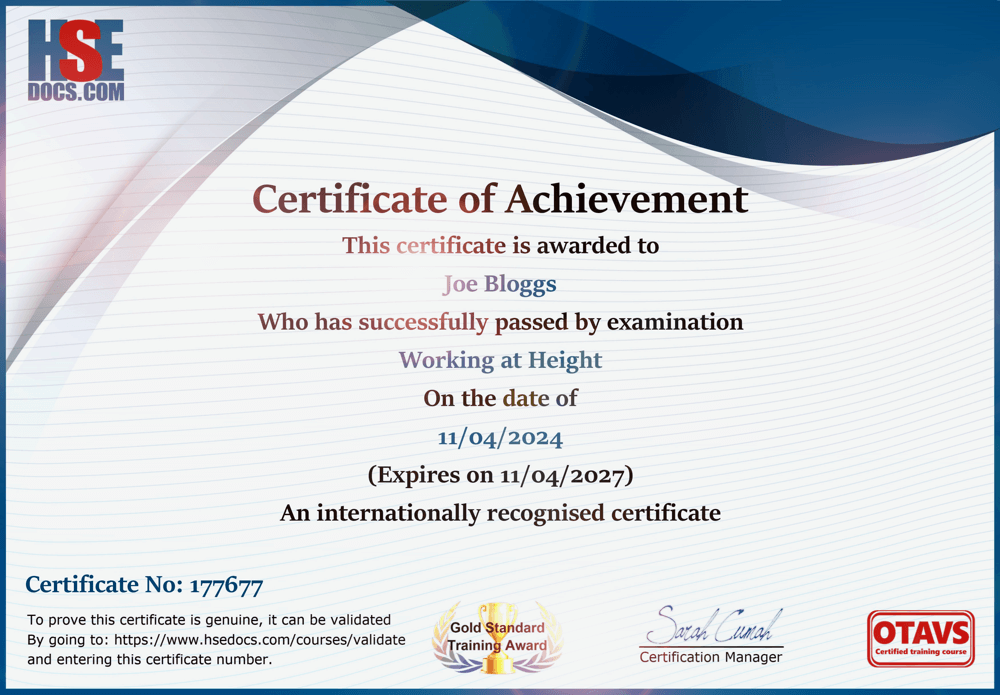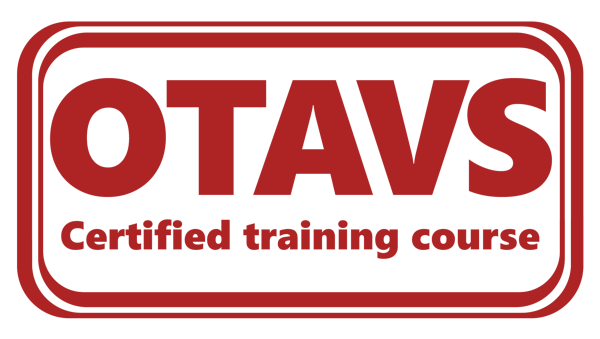Online Display Screen Equipment (DSE) Course
Course certificate valid for 3 years
UK & EU accredited training
Ensure your employees know how to carry out a display screen equipment assessment with our online DSE Course
This comprehensive online training course thoroughly explains the Display Screen Equipment Regulations 1992. It covers how to conduct a workstation assessment, ensuring that it is set up correctly to prevent musculoskeletal complaints.
By completing this training, you'll gain the knowledge and skills to ensure your computer workstation is ergonomically designed and safe for prolonged use.
£9.99 for an individual course, £6.49 if you buy 10 or more, and just £4.99 for bulk orders of 50 or over.
This course is accredited and certified by OTAVS.
Online Training Accreditation & Verification Service
Course duration: Between 1 and 1 ½ hrs depending on learning speed.
Course format: Three video training modules, with a multiple-choice section at the end of each module.
On completion, your training certificate is valid for three years and is internationally recognised.
All training certificates are entered into the national training database and can be verified by employers or others to prove that they are genuine by clicking Validate a Certificate and typing in the certificate number.
Course Overview
The Display Screen Equipment (DSE) regulations apply to individuals who use DSE regularly or on a daily basis for an hour or more in a single session. However, they do not apply to occasional users, such as delivery drivers who use DSE for customer signatures. The regulations include assessing a person's workstation setup to ensure proper posture and prevent eye strain and musculoskeletal complaints. This online course covers various elements and topics related to DSE, including:
- Correct posture, which increases workstation felicity, dampens muscle tension and helps prevent strains and injuries.
- Eye strain prevention, covering topics such as screen-to-eye distance, correct display screen settings, the effects of screen glare and how to reduce it.
- Workstation lighting and the effects direct sunlight can cause if it creates backlight or high-contrast areas within a workspace environment.
- DSE assessment for workstation risks and putting control measures in place.
- Back, neck, upper and lower limb disorders that can be caused by incorrect posture and seating arrangements.
- Having a workstation that is well-designed and correctly laid out.
- Taking regular breaks.

- Do you work at a desk or workstation and sit in the same position for periods of an hour or more?
- Do you use a mouse, roller ball, touchpad, keyboard and display screen?
- Do you use a desk, a chair and a computer?
If you answer 'yes' to any of the above, this course is for you.
- Do you know the correct workstation setup to encourage good posture and the recommended working practices to prevent RSIs, neck, back or limb complaints?
- Do you know how to conduct a DSE assessment with the correct set-up of chairs, armrests, seat heights, and display screen distances to create an ergonomically suitable working environment?
- Do you know how to avoid backlight and ways to reduce eye strain?
- Do you know how often it is recommended to leave your workstation and stretch your legs?
If you answer 'no' to any of the above, then what you will learn in this course is a must. It will improve your comfort at work and help prevent common injuries and disabilities associated with using workstations for prolonged periods.
For people who spend most of their working hours sitting at a desk, DSE (Display Screen Equipment) training is particularly important. It's a common misconception that DSE training is all about preventing eyestrain from looking at the computer screen. Eyestrain is generally a temporary discomfort that has no adverse long-term health effects.
While eyestrain may be a symptom of staring at a computer screen, RSI’s to the neck, back, hand, arm, and shoulder are the most common complaints associated with incorrect computer workstation setups. Therefore, proper DSE training is crucial to prevent physical discomfort and long-term ailments and to promote a safer work environment.
Using a workstation is widely regarded as a low-risk activity. It is considered to be one of the safest working environments a person can have, as it typically involves sitting at a desk and using a computer for extended periods. However, despite the minimal risks of being involved in accidents such as being struck by a moving vehicle or falling from a height, it is important to note that this doesn't necessarily mean you won't suffer injuries. The repetitive nature of certain tasks, poor posture, and prolonged sitting can lead to a range of musculoskeletal disorders and other health issues over time. Therefore, it's crucial to take steps to mitigate these risks and promote a healthy and safe work environment.
A Display Screen Equipment (DSE) assessment involves evaluating the workstation setup to reduce stress and fatigue while preventing common ailments that may arise from a poorly designed workstation. The assessment teaches proper workstation setup and good posture principles, which can help combat musculoskeletal disorders, headaches, eye fatigue, and other related symptoms.
In addition, a DSE assessment educates employees on the importance of ergonomically designed equipment and cognitive ergonomics. The latter is concerned with mental processes such as perception, memory, and reasoning.
For ease of use, the training course is divided into three modules, with a Q&A multiple-choice section at the end of each module.
The pass rate for each module is close to 100%, and you must pass each module to proceed to the next.
If you don't pass a module the first time, you are given as much access to the course material as you need in order to meet the required standard.
Once you have completed the course, you will have instant access to your training certificate which is internationally recognised.
Your Display Screen Equipment (DSE) training certificate is valid for three years.


 CART
CART 















